
The Banquet of Nations
This is Part 11 of our series “Opening Day of the World’s Fair,” which explores the events of May 1, 1893, at the World’s Columbian Exposition in Chicago. The full series can be found here.
Pushing the button that launched the great transformation scene to open the 1893 World’s Fair was not the end of the duties of the President of the United States on May 1.
Escorted to the café
Hardly had the Opening Ceremony of the Fair been declared over than Director-General Davis seized Mr. Cleveland—gently, but firmly—and escorted him off the stage of the grandstand. Accompanied by Presidents T. W. Palmer and Harlow Higinbotham, they made their way into the Administration Building, across its wide central court, and into an elevator.
Luncheon had been arranged for a select number of guests in a dining room that had been set up on the third floor of the northwest pavilion of the building. Not everyone heading up, however, was aware that there was a guest list.
President bows to the Indians assembled
After the conclusion of the ceremony outside, Major John Burke, public relations man for Buffalo Bill’s “Wild West” show, led a group of Lakota (then called Sioux) into the rotunda of the Administration Building, where they formed a square underneath the great dome. Chief No Neck stood in the center, in a position of honor. They waited to greet President Cleveland on his way to the luncheon, but had just missed him. As foreign visitors passed by on their way to the café, the Indians let out a loud cry that made the statuary of the building tremble.
Major Burke led the Lakota to the elevator and up to the third floor, where they gathered in a line outside of Director-General Davis’ office. President Cleveland came out and bowed to them. Each Indian shook his hand before departing the fairgrounds.
A legendary round table

“The Breakfast Table in the Administration Building” from the Chicago Herald, May 2, 1893.
The dining room arranged on the third floor offered a beautiful sight. The entrance was curtained with a portiere and flags woven around the pillars and draped about the arches of the windows honored the foreign guests. Against a backdrop of cream tints, huge banks of green plants and sweet-smelling flowers filled the space. Huge palms and pots of Easter lilies decorated the luncheon room, and other plants filled the big windows.
A forty-foot diameter circular table made for a most dramatic sight. The round table surrounded four large pillars. Filling the center were flowering plants and shrubs and an immense pyramid of palms, cedars, and evergreens—some fifteen feet high, so that when guests were seated it was quite impossible for one to see who sat directly opposite them. Around the inner border of the banquet table was decorated with a girdle of roses and ascension lilies, begonias, and a beautiful bush of calceolarias. In front of the President’s plate was placed a lemon azalea.
On the table, hand-painted Haviland china and glistening crown Hamilton silverware stood out to great effect.
Nobody seemed to have the slightest idea of who was invited
It was a difficult matter to seat so many people in so small a room. To make matters worse, there were more people than available seats.
For several minutes after the President and his party reached the café, none of the Committee on Ceremonies in attendance knew what to do. The result was that the lobby, which should have been kept clear, was crowded with eager spectators. Owing to some mismanagement, a number of uninvited persons worked their way into the dining room and helped themselves to seats at the table, to the exclusion of distinguished guests bearing an official invitation. These distinguished personages therefore found themselves in the awkward position of standing about. Nobody seemed to have the slightest idea of who was invited.
The guest list

“Guests at Luncheon” from the Chicago Inter Ocean, May 2, 1893.
The officially invited guests—limited to seventy—eventually found their seats around the two half-circles. President Cleveland occupied the seat of honor on the western side of the room, opposite the entrance, and President Thomas W. Palmer faced him across the table. Mrs. Potter Palmer, President of the Woman’s Board, and President Higinbotham, of the local directory, faced each other exactly half way round the circle from Mr. Cleveland on the east side of the room.
Other guests were ranged around the table in the order of precedence and included the cabinet officers and their wives, the Duke of Veragua and his suite, officers of the lady managers and national commission, officers of the directory, the Governor of Illinois, and Mayor of Chicago. Foreign dignitaries and ambassadors included Baron Saverio Fava, the Italian Prime Minister; the Turkish minister; Marchesi Enrico Ungaro, the royal commissioner from Italy; Prince Mario Ruspoli of Italy; the Netherlands minister; Dr. Francisco E. Bustamante of Venezuela; the German minister, the Prince of Trenberg, Senator Edward Arbaili of Italy, Marquis Rudini of Italy, G. Tadeno of Japan, Count Sponnek of Denmark, Prince Mikhail Cantacuzène of Russia, Prince von Isenburg of Austria, Raymond Le Ghait of Belgium, and Thomas F. Bayard, Ambassador to the U.K.
He served four presidents
Forty-four black waiters, representing the number of states in the Union in 1893, served the luncheon provided by the Wellington Catering Company. The waiter serving President Cleveland was J. A. James, who shared this personal story with the 22nd and 24th president: “I have waited on four presidents. I waited on President Hayes at Atlanta, Ga., President Arthur at Washington, D.C.; President Harrison at Galesburg, and President Cleveland here today. No, I didn’t ask for the honor. It just happened that way.”
The banquet menu
The menu for the luncheon was:
Consommé Colbert
Soft Shell crabs
Julienne potatoes
cucumbers
roast tenderloin larded with fresh mushrooms
Hollandaise potatoes
French peas
Roman punch
Broiled snipe with bacon
Lettuce and tomato salad [or celery and potato salad]
Strawberries and cream
cheese
coffee
The only wine served at the table was champagne, the ladies taking a brand a little less dry than that used at the western part of the circle.
Glasses raised

“Around the Banquet Board” from the Chicago Inter Ocean, May 2, 1893.
After the fourth course, President Higinbotham rose and toasted the health of Mr. Cleveland:
“Ladies and Gentlemen, the President of the Board of Lady Managers and the Duchess of Veragua have suggested that we drink to the health of the President of the United States, which we now proceed to do. [Looking to the ferns and palms.] Although there is something between us, I think with this bond we will all be in complete rapport.”
A little latter President Palmer said: “Ladies and Gentlemen, we now drink to the good health of our honored guests, the Duke of Veragua and the Marquis de Bárboles.” President Cleveland was the first to rise, and all followed his lead.
Then President Palmer rose and said that he intended to propose a toast which, though rather informal, would lose nothing in sincerity. He said: “We have drunk the health of the President of the United States, but we have with us the lineal descendant of Columbus, the discoverer of our country. Let us now drink to the health of our distinguished guest from Spain.”
Off to the Woman’s Building
Time for lunch was short, and most diners never reached the dessert course.
Before the cheese and coffee were brought on the table, Mrs. Palmer whispered to the duchess and told her that it was time for them to move toward the Woman’s Building. All the ladies rose, and there was a little confusion at the table. The President had not given the signal for rising, and everyone thought the luncheon was ended. The ladies, however, hastened away to take part in the dedication of the Woman’s Building. President Cleveland sat down again and enjoyed cheese and coffee, as several guests came around to his chair to chat with him. He stayed for a few minutes in the luncheon room and was apparently much pleased at the reception which had been given to him in the morning.
Clap of thunder halts the president’s smoking
As the President smoked his Havana he turned around, leaned against the table in a resting attitude, and chatted with Mr. Palmer about the wonders of the Fair. He then retired to Mr. Palmer’s office for a half hour of solid enjoyment, taking in the stunning view of the Court of Honor out the east-facing window. The crowd below spotted him and cheered, which the president acknowledged with a bow.
Somebody had given the president a nice, long cigar, and he was anxious to test it. He was too anxious, in fact, for it is recorded that he lit it just as he was about to enter President Palmer’s room. A Columbian guard interrupted him, and the order came like a clap of thunder: “Put that cigar out! No smoking allowed in this building today!” Mr. Cleveland obeyed with alacrity. “I can brave the wrath of the Tammany tiger,” the president explained “but of the Columbian guard, never!”
Mr. Cleveland recently had been diagnosed with a cancerous growth in his mouth, but had kept the news a secret. After returning to Washington following his visit to the World’s Fair, he had the tumor removed during what was called a “fishing trip.”

“Guests Descending from the Breakfast” from the Chicago Herald, May 2, 1893.
SOURCES
(See our note about sources here.)
“Arrangements Not Complete” Chicago Daily Tribune May 2, 1893, p. 5.
“Banquet of Nations” Chicago Inter Ocean May 2, 1893, p. 1.
“Cleveland Presses the Golden Key” Salt Lake Herald May 2, 1893., p. 1.
“Epoch in History” Chicago Herald May 2, 1893, p. 1.
“He is Coming Back” Chicago Inter Ocean May 2, 1893, p. 1.
“Mr. Cleveland at Luncheon” Chicago Herald May 2, 1893, p. 2.
“Near Half a Million” Chicago Daily Tribune May 2, 1893, p. 3.
“Opened to the World” Chicago Eagle May 5, 1893, p. 6.
“Opening Ceremonies World’s Columbian Exposition” in Columbian Exposition Dedication Ceremonies Memorial. Metropolitan Art Engraving & Publishing Company, 1893, pp. 212-224.
“Presidential Party Takes Lunch” Chicago Daily Tribune May 2, 1893, p. 1.

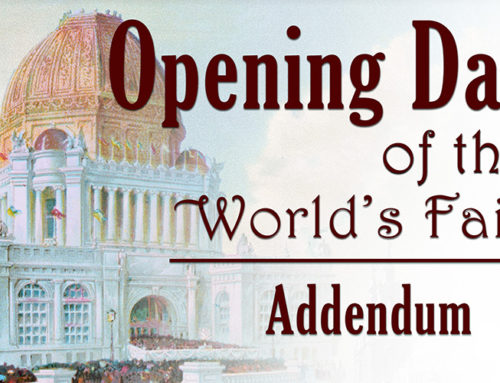
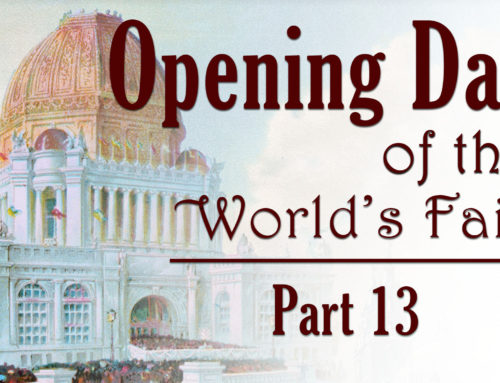
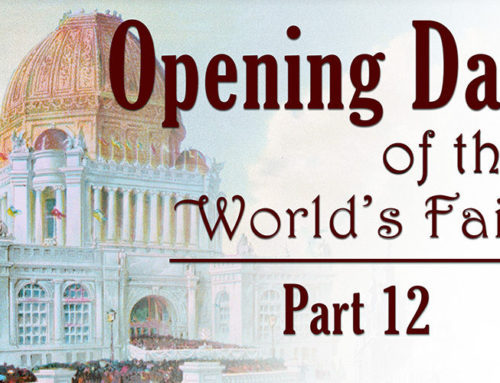
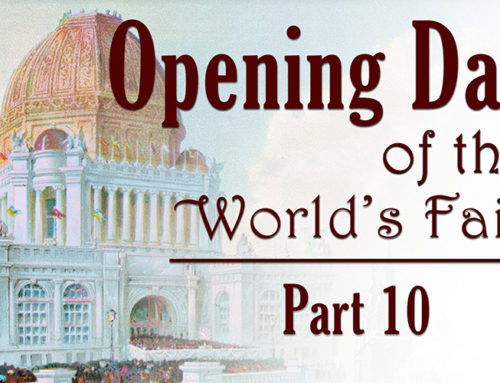
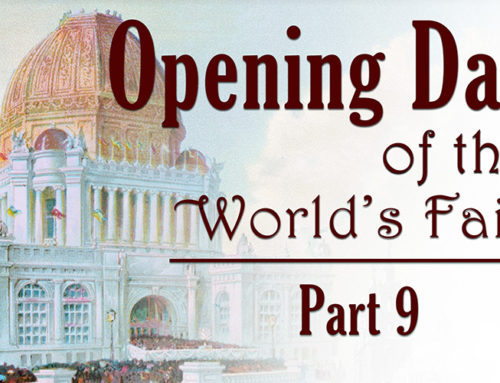
Leave A Comment